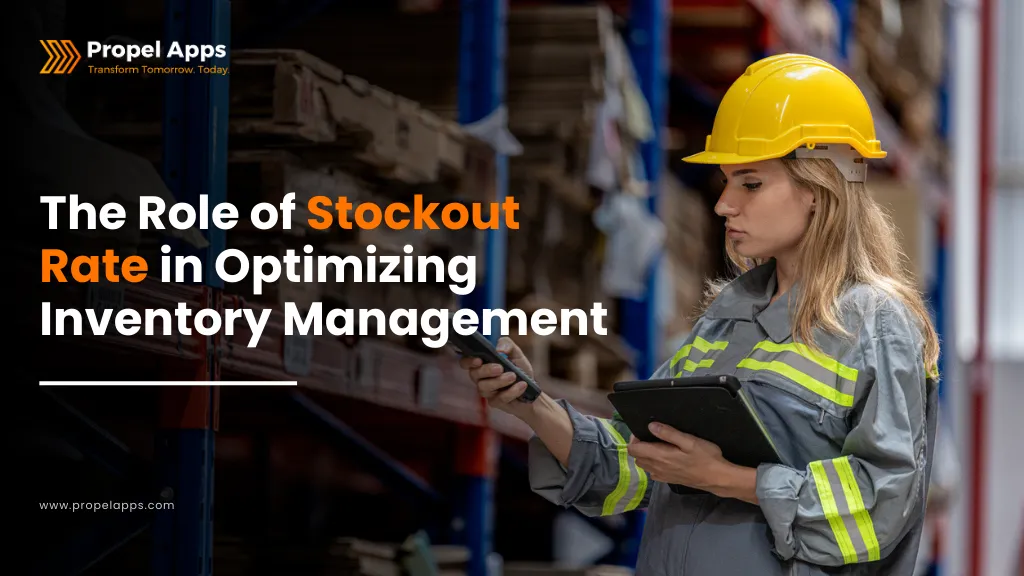
As you navigate the complex world of inventory management, understanding key metrics is crucial for optimizing your operations and ensuring customer satisfaction. One such metric that plays a pivotal role in this process is the Stockout Rate. In this blog, we will explore what a stockout rate is, how to calculate it, and its significance in inventory optimization.

Stockout rate is a vital metric that measures the percentage of times a product is out of stock when there is customer demand for it. It reflects your company's ability to meet customer needs and maintain adequate inventory levels. Stockout rate is calculated using the following formula:
Stockout Rate = Number of Stockouts/Total Number of Opportunities for Sale × 100
For instance, if you have 15 stockouts in a month and 500 total sales opportunities, your stockout rate would be 15/500 × 100=3%. This means that 3% of the time, customers encountered an out-of-stock situation when they wanted to purchase the product.
Stockout Rate is more than just a metric; it's a strategic tool that helps you optimize your inventory management in several ways, such as:
A low stockout rate ensures that products are available when customers want them, leading to higher satisfaction and loyalty. Conversely, frequent stockouts can frustrate customers, causing them to seek alternatives.
Stockouts directly impact sales by preventing purchases, which translates to lost revenue opportunities. By minimizing stockouts, you can maximize sales potential and maintain a competitive edge in the market.
Consistently meeting customer demand helps build a positive reputation, crucial for long-term business success. High stockout rates can undermine this effort by signaling poor inventory management.
Monitoring stockout rates provides insights into inventory management efficiency, helping identify areas for improvement. It can highlight issues such as forecasting inaccuracies or supply chain inefficiencies.
By analyzing stockout rates, you can set realistic targets for inventory replenishment, safety stock levels, and demand forecasting. This data-driven approach ensures that your inventory strategies align with customer expectations and market conditions.
High stockout rates often lead to increased costs due to expedited shipping or holding excess safety stock. By optimizing inventory levels based on stockout rate analysis, you can reduce these unnecessary expenses.
A mobile inventory management solution plays a crucial role in reducing stockouts by providing real-time visibility into inventory levels and automating data collection. This solution allows businesses to track stock movements accurately, enabling timely replenishment and minimizing the risk of running out of stock.
In this context, look for the right mobile inventory management solution that works best for your warehouse, while your inventory personnel should be at ease operating the solution. This means the solution should be intuitive, user-friendly, and, of course, cost-effective. While there are a couple of good solutions in the market, one solution that stands out in the crowd with its intuitive design and cutting-edge features is the Propel Apps’ mobile supply chain management solution.
This solution easily integrates with your in-house ERP system (Oracle SCM Cloud, Oracle EBS, or SAP S/4 HANA), providing your warehouse personnel with instant access to ERP data anytime, anywhere. In other words, this solution empowers your warehouse and inventory personnel to access real-time data from ERP, perform simple tasks, and get work done, devoid of any lengthy manuals or support from either business or IT. To know how this solution makes a positive impact on your overall warehouse and supply chain operations, schedule a free demo with us.
According to a Gartner report, companies that adopted mobile inventory solutions saw a significant reduction in stockouts by up to 25%.
The stockout rate is a powerful metric that not only measures inventory management efficiency but also guides strategic decisions to improve customer satisfaction, sales, and overall business performance. By understanding and leveraging this metric, you can refine your inventory management processes, reduce stockouts, and enhance your competitive advantage in the market. Whether you're in e-commerce or traditional retail, optimizing your stockout rate is essential for maintaining a robust supply chain and ensuring long-term success.
As you move forward, consider integrating advanced inventory management tools and strategies, such as automated systems, RFID technology, and vendor-managed inventory, to further optimize your stock levels and prevent stockouts. By doing so, you'll be better positioned to meet customer demand effectively and maintain a strong market presence.